Bike Rafting The Trinity River and Mountain Biking The Great Trinity Forest
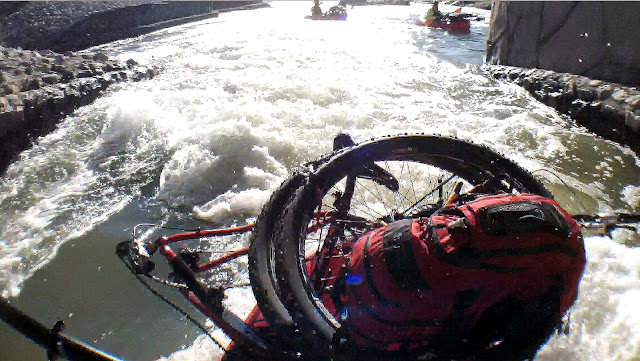 |
| Bikerafting through the Trinity River Standing Wave Whitewater Upper Canoe Bypass in Dallas, Texas |
Our specially crafted boats, by design, should have been somewhere north cutting a wake on the Arctic Sea Ice or carrying a field dressed moose across an Alaskan fjord. The weather was cold enough. The whitewater rapids strong. A pair of Bald Eagles, the distant noon howl of coyotes and Northern Shoveler ducks by the thousand to keep us company. An Alaskan adventure in every since of the word. I’m sure four months from now those same eagles and ducks will most likely be in the land of the Canadian midnight sun. But not this day. It was mid-February. In Texas. The only thing resembling ice was spelled out on the Katy Trail Ice House marquee where this trip started and finished.
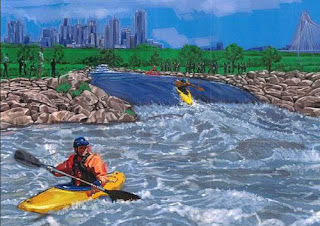 |
| Trinity River Standing Wave Sketch circa 1998 (City of Dallas) |
Five years ago, the sights, sounds and place names in this post did not exist. They were blueprints, sketches and dreams of benchmarks yet to be realized. The foundations of the Trinity River Corridor now affords those with some creative outside-of-the-box ideas and a sense of adventure to do things really unique on a Saturday morning. Labeled boondock country by many, wrongfully mired in political debate, the true nature of the river becomes difficult to conceive as a whole.
The Trinity River Project could be seen as a blank slate yet to make a mark on the city that surrounds it. There seems to be a fundamental misunderstanding about how many of these projects can be woven together into a twenty mile journey up and down the Trinity River. Limited only by your own imagination there are ample opprotunities for adventure. It’s fun to see these renderings come to life, whether they are a signature bridge, a bike path, nature center or whitewater park.
 |
| Evan and Will of Big City Bike Rafts |
Two such pioneers literally testing the waters of the Trinity River are Will and Evan, two Dallas residents who bike raft rivers around the Southwestern United States. Together they formed Big City Bike Rafts that will rent you an Alpacka raft for a modest fee. Will mentioned that they bought the rafts after a long search for a Trinity trip last summer. They had to source the raft rentals from Jackson Hole and Salt Lake City at great expense and trouble. Bitten by the bike rafting bug and not wanting to go through the expense of mail order renting they purchased a set of rafts. Will and Evan shot me an email earlier in the winter about a float/ride through the Great Trinity Forest and I jumped at the chance.
The Equipment
At first glance one might see inflatable boats as a mediocre way to travel on water. These are no ordinary boats. Built by Alpacka Raft in Mancos, CO, they are the preferred choice for many cross country adventure travelers. Weighing in at five pounds and rolling up to dimensions the size of a loaf of bread, they allow for real flexibility in travel. Jonathan Waterman, author of the book published by National Geographic Running Dry: A Journey From Source to Sea Down the Colorado River used an Alpacka on his 1450 mile journey from the source of the Colorado River on the snowpack in Colorado’s Rocky Mountain National Park all the way through Arizona’s Grand Canyon and down to Mexico’s Baja. Impressive boats with a load capacity in excess of 350 pounds and good steering manners.
| Will giving a demo on assembling the raft |
They assemble and inflate in about five minutes using a unique pillowcase style bellow rather an a traditional pump. Simply grab some thin air then run your closed hand down the length of the blue bellow, pictured left at the Dallas Standing Wave Portage Ramp. Rated for Class III intermediate rapids, the finesse issue of the handling lies more in getting your load balanced and center of gravity low.
The boats don’t carry through with as much of a gliding coast like a canoe but make up for it with added maneuverability and less draft it seems.
The Route Downriver– Katy Trail Ice House to the Audubon Center
There must be thousands of people who use the Katy Trail on a Saturday. Few venture far off it. The trail itself serves as a great avenue for reaching other parts of Dallas. The Arts District, the American Airlines Center, the Audubon Center! Originally the MKT railroad, the old line cuts a bee-line right to the old river channel.

Above is the Google Map Route for the trip down the river starting at the Katy Trail Icehouse and heading south across the Continental Street Viaduct. The return trip was similar and can be found further down in the post. For those that keep score with their GPS, I believe Will of Big City Bike Rafts holds the Strava KOM for the route.
Relevant benchmark mileage points:
5.5 miles from the Katy Trail Ice house to the Trinity River Standing Wave.
6.2 miles down river from Standing Wave to Loop 12. 11.8 total miles from Ice House to Loop 12
4.7 miles from loop 12 to the Audubon Center. 16.5 miles total from Ice House to Audubon Center.
On walls that once housed the Italian Restaurant Cremona are chalkboards that line the exterior. Entitled “Before I Die I Want To..” the chicken scratched scribble of strangers profess things they always plan on doing but might not get around to in this lifetime. We were set on ours………
….and that’s where our trip began on a cool, serene saturday morning. In stark contrast not twenty five minutes later we were wet and in a washing machine of Class II-Class III rated whitewater.
Getting to the river is a snap. Down Continental and across the bridge one can be on the levee perimeter road in mere minutes. Open year round to non-motorized traffic the levee road is slowly becoming known as a great training ground for off-road cyclists and running groups looking for softer surface training.
 |
| Trinity River Levee Perimeter Road with the Margaret Hunt Hill Bridge in the background |
Currently the only paved stretch of trail is a short section of path from the east side of the I-35 bridge to the west side Santa Fe Trestle Trail on the Oak Cliff bank of the Trinity.
| Assembling rafts and disassembling bikes |
29er mountain bikes are quickly gaining in popularity and outselling traditional smaller wheeled 26 inch mountain bikes in many stores. For this trip we all rode 29ers which suit themselves well to North Texas trails. Disassembling the bikes and mounting the larger wheeled bikes on the rafts was a snap. The boats have straps and attachment points similar to the old clipped pedal cages of pre-SPD style pedals. By design the teeth of the clasps hold strong even when wet and the webbed material will not stretch.
The Dallas Wave — Running the Trinity River Project’s Standing Wave
 |
||
| Launching from the Portage Ramp and approaching the Standing Wave |
The scrawny meandering wooded stream known to many as the Trinity River does not exist in the first one hundred yards downstream of the Santa Fe Trestle Trail. Here a canoe portage ramp exists serving as a bookend of where the Trinity River levee floodway ends and the untamed wild river begins. Whitewater.
Video summary of the trip, including negotiating the Standing Wave
| June 2010 |
Construction began on the Standing Wave in the summer of 2010. Using a diversion channel the Trinity River was temporarily moved to the north allowing for foundation work in the riverbed.
 |
| August 2010 |
By Christmas of 2010 the Standing Wave was complete. Below is how the Standing Wave looked just prior to the Trinity River being placed back into the original channel.
 |
| December 2010 |
 |
| Taking the purpose built canoe bypass on the Standing Wave Project |
The approach to the Standing Wave is uneventful the roar of the rapids beyond cannot be heard until reaching the lip of the feature itself. We decided to take the River Left canoe bypasses, a pair of which allow for a somewhat calmer traverse of the whitewater.
 |
| Upper Wave slackwater area of the Trinity River Standing Wave |
Above is the slack water Upper Wave play area. The hydraulics of the water seem to move counterclockwise in the upper pool, gently swirling around.
 |
| Negotiating the Lower Canoe Bypass |
The Lower Canoe Bypass has a considerable drop to it, much more than the Upper Bypass. Seen above, the water has a faster speed, longer drop and more run out. I recall that attempts have been made to fix this problematic spot, placing a large boulder near the lip of the bypass to curtail the flow, reworking some of the funnel. Where the Upper Bypass is a piece of cake, I think that a larger boat like a canoe might think twice about negotiating the Lower Bypass. Portaging might be a better option.
 |
| Lower Standing Wave looking upstream Corinth Street Viaduct in far background |
The Lower Standing Wave is an easier piece of water to dabble in. This particular day the water was a modest 700 CFS which would be considered an average flow year round. In the summer it drops off to 450-500 CFS during dry spells.
Beyond is the scenery of which Dallas can now boast, the sort of natural areas that people just don’t see on their way down I-45 to Houston.
The Journey Downriver
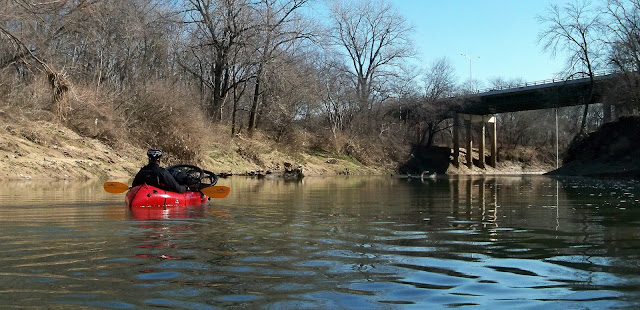 |
| Approaching the Cedar Crest Bridge |
The Cedar Crest Bridge is the first bridge on the float one reaches about 1/3 of a mile downstream of the Santa Fe Trestle Trail. Soon, the Corps of Engineers will radically alter the woods here, removing most of the trees to build wetland cells. It has already begun to some extent with the removal of a forested area on the southwest side of the bridge. Hope they know what they are doing!
 |
| MKT Trestle circa 1905 |
Hey, it’s the Katy again. The next bridge up is rumored to be one of the oldest railroad bridges still in use that spans the Trinity, the MKT railroad bridge. Hidden from any street view one can only see it from the river. Interesting old bridge, the random train horns from locomotives crossing here keep South Dallas residents up at night.
Some of the more detailed history and backstory of this stretch of river can be found in a previous post from November on a canoe trip with a historian, wildlife expert, two master naturalists and a pig blood drone pilot Exploring the Trinity By Canoe.
Beyond the railroad trestle, the river exhibits a cross section of the sediments that underlie the Blackland Prairie plains, an apron of gravel debris laid down anciently by immense rivers coursing out of the mountain west when those peaks were young and high. Behind the old Procter and Gamble Plant the gravels here point to a much older time.
Miller’s Ferry
 |
| Historic Miller’s Ferry Site |
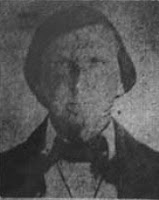 |
| William B. Miller |
Miller’s Ferry has been used for centuries by man as a way station on the Trinity River. This trip we used it to stretch our legs as the halfway point of our float. Nestled between the elevated I-45 and Highway 310 bridges it serves a great rest stop. Despite the heavy rains of the previous week, the ground was slippery but firm.
The namesake of the crossing is William B. Miller an early Dallas pioneer who made a lasting mark on much of Dallas as a whole. An enterprising businessman on the south bank of the Trinity, he needed a ferry crossing to reach Dallas. In turn, Dallas needed a reliable ferry crossing to reach Hutchins, Corsicana and points south. Miller’s Ferry road still exists today in southern Dallas County and served as the piggybacked route for the first railroad, first highway and first interstate into Dallas.
The debris and scree today at Miller’s Ferry look like a standard mess of old rusted construction but in reality are the remains of bridges and crossings past. In the photo above, the concrete casements, iron shrouded piling and cable pieces are legacies of old times gone by. The first ferry was hand pulled, similar to the one seen inset left. During low water, the cottonwood built ferry sat in the mud and served as a low bridge. During high water the bridge was pulled via rope and braided cables. It’s believed that the “cut” in the bank(where we parked our boats in the photo) at Miller’s Ferry, shown as a historical feature most likely was part of that old site.
 |
| Millermore Mansion in Old City Park |
Miller’s antebellum style mansion, Millermore was moved to Old City Park near Downtown Dallas where it stands today. There is much more history to the ferry site which can be found in more detail in a previous post 3000 years of history at Miller’s Ferry .
Through Rochester Park and up White Rock Creek
 |
| Navigating the mouth of White Rock Creek, looking upstream |
 |
| Remote canoeists camp on White Rock Creek |
A distant howling chorus of coyotes greeted us as we floated past the Buckeye Grove in Rochester Park now known as William Blair Park. Eerily calling a noon howl from afar the true wilderness of the river made it’s mark. Below the Buckeye Grove sits the mouth of White Rock Creek which is usually hard to travel due to snags. This day the flow and level of the creek was higher allowing for further travel upstream.
The sheltered creek mouth here makes for an excellent stop and makes for an excellent overnight canoe camp spot on the river, high and away from the bank.
Downstream to the east of the river we floated past what will soon become the Trinity Forest Golf Course. The tall pecans, walnuts and oaks that line the banks here will most likely hide the course from the river. Once an old gravel mining area, this parcel of land yields some of the finest fossilized animals in the United States. The old gravels mentioned earlier in this post served as a vast sandy marsh when mammoths roamed Dallas. The new Perot Museum of Nature and Science in Dallas features a mammoth pulled from this very spot, soon to be a golf course.
Take Out at Loop 12
We took out at the Loop 12 Boat Ramp where the Trinity River Trailhead begins and travels through Joppa Preserve on a 4 mile paved path that loops around to the Trinity River Audubon Center. From here it’s all bikes. Dismantling and packing boats and assembling bikes on a jaunt down the river to the Audubon Center.
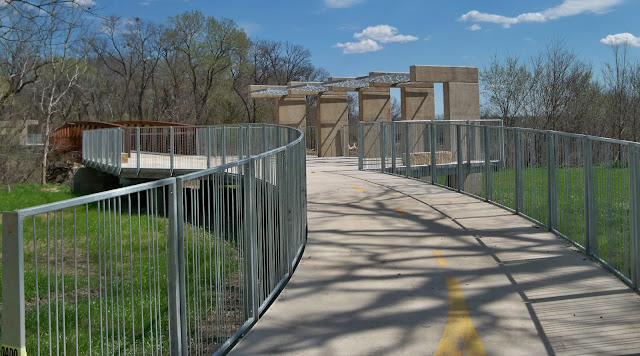 |
| Trinity River Trail Bike Path Bridge Over The Trinity River |
The multi-million dollar bridge here has been completed for at least a year. Final completion of the trail was held up due to a Water Utilities project of riverbank stabilization. The trail skirts the Audubon property with a new solar powered trailhead near the Audubon Center entrance.
| Trinity Trailhead on the Audubon Center entrance way |
This lot as well as the Audubon Center itself will serve as a great jumping off point to exploring the Great Trinity Forest in the future. I think there are still some wrinkles to be ironed out in regards to using this particular trailhead when the Audubon Center is not open. I had a conversation with Don Burns, the Trinity River Project Manager last week who explained that new interior gates were in place for the Audubon Center drive to accommodate trail users.
Speaking of the Audubon Center, we were met by Ben Jones the director of the Audubon Center and a staff member in the center’s breezeway. Will and Evan’s photo made the Audubon Center’s blog:
http://trinityriveraudubon.tumblr.com/post/43272339659/great-backyard-bird-count-2013-over-30-unique
Ben Jones mentioned that this day in particular was a peak day for the annual hawk migration and it clicked with us since we had seen so many hawks while on the river. The final count of hawks for our party was in the ballpark of two dozen hawks and two Bald Eagles, one mature adult and one juvenile.
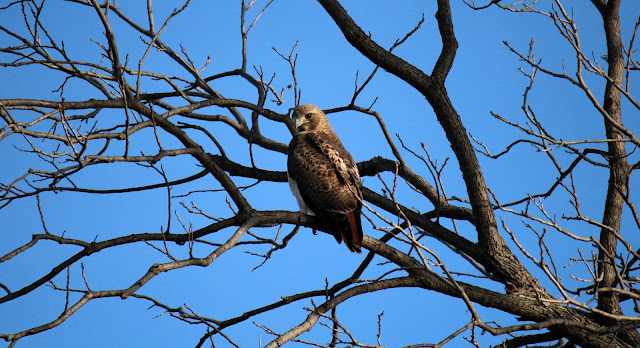 |
| Red-Tailed Hawk near Miller’s Ferry on the Trinity River |
 The hawks we saw that day were moving through just like we were. On the way to somewhere else. Most had rather inquisitive eyes and allowed us to get quite close and in many cases just stayed on perch rather than take flight.
The hawks we saw that day were moving through just like we were. On the way to somewhere else. Most had rather inquisitive eyes and allowed us to get quite close and in many cases just stayed on perch rather than take flight.
Return Route
Google Map Route Return Route Above is the return route used in the trip. Utilizing the Trinity River Trail from the Audubon Center to Loop 12. The next section follows the crude doubletrack of the Wetland Cells abutting the Freedman’s community of Joppa to Highway 310 at Miller’s Ferry. Crossing the bridge and taking South Lamar through the Bon-Ton, Cedars and eventually Downtown Dallas back to the Katy Trail.
14 miles, one way. If someone wished to ride mountain bikes, a cyclocross bike or even a beach cruiser from Uptown or Downtown to the Audubon Center this is the very best route to take. We took this route back to make it as clear and concise as possible for anyone else wishing to replicate the route. Naturally, there are many other side routes, detours and trails one can take off this route. I think one will find that the generosity, friendliness, in its width and scope among the people there is unique to Dallas. It is good-people country.
Wetland Cells
 |
| Evan riding the Wetland Cells approaching Highway 310/Lamar |
Riding back was quite simple. Up the bike path towards Loop 12, then across Loop 12 to the Wetland Cells. Here we followed a simple set of doubletrack dirt road that loosely follows the chain of wetland cells up towards I-45. One can ride as far as I-45 at Overton. Since we were on bikes, we vacated the river at 310@Overton. Here the highway bridge affords a wide shoulder and low vehicle traffic. Often crossed on foot, bike and horse by area residents, it’s a good bridge to cross for our purposes.
 |
| Lamar Street under the Dallas Convention Center |
Up South Lamar and only minutes later we are riding into Downtown Dallas. On the ride back, people become part of the landscape. The liquor store lot Day Drinkers along South Lamar. The vagabonds pushing shopping carts full of things others have built, destroyed or thrown away. The newly minted parolees stepping out of the Greyhound Bus Station. The tourists of the West End wearing sweatshirts of distant colleges unknown in these parts. Ten minutes is all it takes on Lamar to go from the poorest of the poor to the richest of the rich. An interesting slice of humanity.
 Lamar has become newly marked in late 2012 and early 2013 with shared bike lane symbols from the Convention Center to the Katy Trail. We used the marked lanes on our ride past John Neely Bryan’s cabin site in the distance and through Victory Park back to the Katy Trail. Great adventure. One you can take too.
Lamar has become newly marked in late 2012 and early 2013 with shared bike lane symbols from the Convention Center to the Katy Trail. We used the marked lanes on our ride past John Neely Bryan’s cabin site in the distance and through Victory Park back to the Katy Trail. Great adventure. One you can take too.
Seems that much of this kind of thing is new to Dallas and still lacks an anchor point for exploring down the river. The next few months are the very best time to visit the Great Trinity Forest.
New projects like Dallas County’s Gateway Park seen below at Dowdy Ferry and I-20 will open up river access to the far reaches of Dallas this spring. The large fishing piers, horse trailer parking and trails will open up a large part of the Great Trinity Forest that few have ever seen. Gateway Park will connect with the Trinity Trail near Audubon Center within the next year.
For those seeking high adventure, rolling your own way and no hand holding, the Great Trinity Forest and the Trinity River itself serve as a great venue to really push your limits. It continues to amaze me that more people do not get down here and explore. On this fine Saturday, other than the sole fisherman who drowns worms at the wastewater treatment plant outlet and a guy with a stuck 4×4 in the Wetland Cells, we saw ZERO people. Amazing.
 |
| Dallas County Gateway Park at Dowdy Ferry and I-20 |
A special thanks once again to Will and Evan. Best of luck on their new venture and new adventures exploring rivers abroad!






